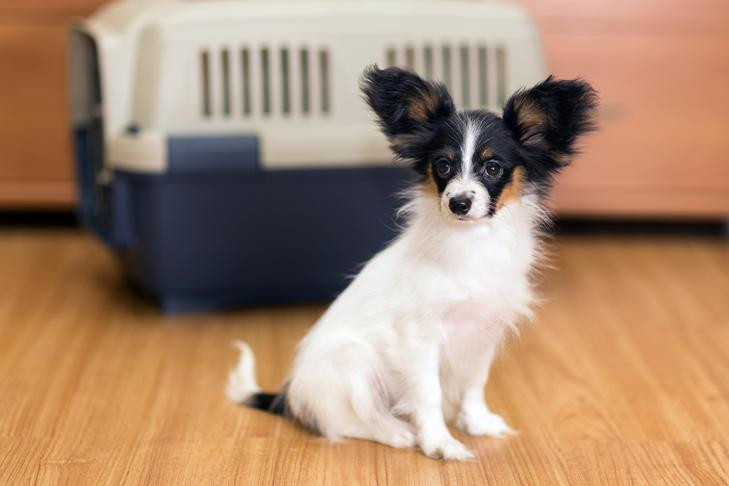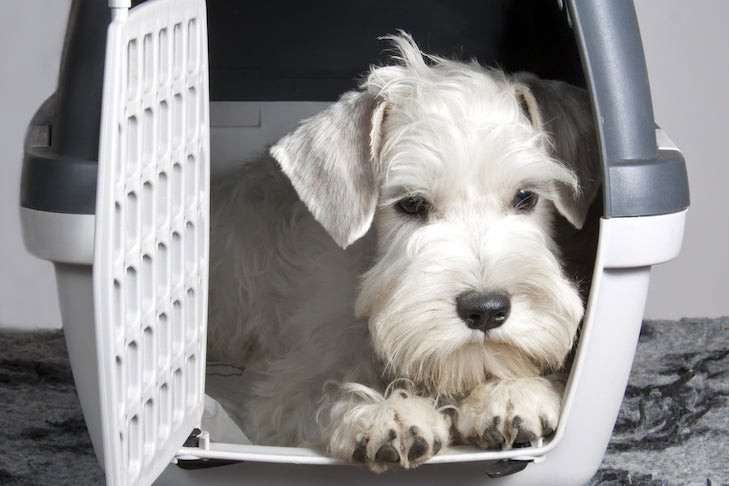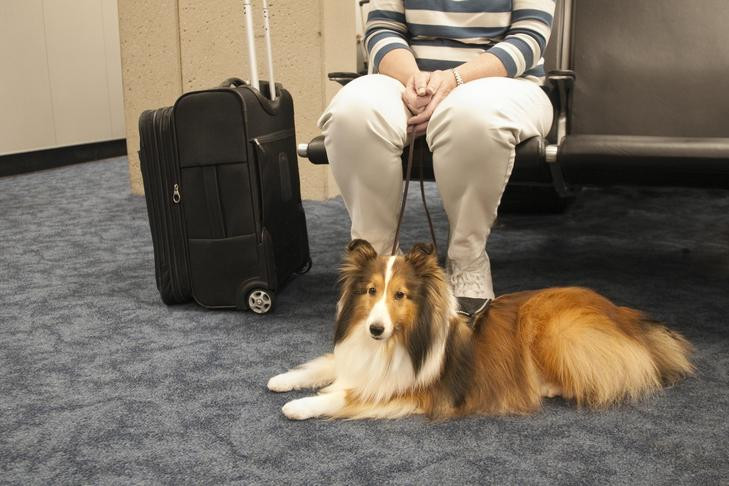Can My Dog Fly On A Plane With Me? Yes, many airlines do allow dogs to fly, but it’s crucial to be well-prepared to ensure a smooth and stress-free journey for both you and your furry friend. Flyermedia.net is here to guide you through the process, covering everything from airline policies to essential preparations, making air travel with your dog a pleasant experience. Understanding these regulations, carrier options, and pet-friendly travel tips are essential for all pet owners considering air travel.
1. Is Flying Right for Your Dog?
Before you book that flight, take a moment to consider if air travel is truly the best option for your canine companion. Traveling can be taxing for both people and pets. Here’s what to consider:
- Stress Factors: According to Dr. Jerry Klein, Chief Veterinary Officer of the American Kennel Club, the unfamiliar sounds, sights, and smells of airports and new destinations can be overwhelming for dogs.
- Health Considerations: Changes in diet and water can disrupt a dog’s gastrointestinal health. Time-zone changes and travel stress can also lead to dehydration or interfere with medication schedules.
- Veterinary Consultation: Always consult your veterinarian to determine if flying is safe and appropriate for your dog, especially if your dog has pre-existing health conditions.
 Papillon in travel crate
Papillon in travel crate
2. Planning and Preparation: Setting the Stage for a Smooth Flight
Proper preparation is key to ensuring a safe and comfortable journey for your dog.
- Airline Communication: Contact the airline well in advance, ideally when booking your tickets, to understand their specific pet policies. Airlines often have restrictions on the number of pets allowed per flight.
- Destination Research: Confirm if your destination has any quarantine, vaccine, or other restrictions for dogs entering the area. The AKC provides a state-by-state travel requirement list, and it’s essential to check for international travel requirements.
- Direct Flights: Whenever possible, book direct flights to minimize stress for your dog.
- Temperature Considerations: If traveling in summer, opt for early morning or evening flights to avoid the hottest part of the day. In winter, midday flights are preferable to avoid the cold. Be aware that extreme temperatures can lead to restrictions on dogs flying in cargo.
3. Navigating CDC Guidelines for U.S. Entry
If you’re bringing a dog into the U.S., be aware of the Centers for Disease Control and Prevention (CDC) guidelines that went into effect in August 2024.
- Dog Import Form: Submit a CDC-approved Dog Import Form online in advance if your dog is entering the U.S. for the first time or returning from another country.
- Vaccination and Microchip Requirements: All dogs entering the U.S. must be immunized against rabies, be at least 6 months old, and have an International Standards Organization standard microchip.
- High-Risk Countries: Dogs coming from a high-risk country may also need a U.S. rabies vaccine certificate, a certification of foreign-issued rabies vaccination, or a microchip form. Quarantine may be required in some cases.
4. Health Checklist: Ensuring Your Dog is Fit to Fly
A healthy dog is a happy traveler. Consider these health-related steps:
- Veterinary Appointment: Schedule a checkup with your veterinarian. While a health certificate may not be required for all domestic flights, your vet can confirm your dog is healthy enough to travel, provide vaccination updates, and issue an updated rabies certificate.
- Medication Preparation: Pack an adequate supply of any prescription medications your dog takes, including preventative flea and tick medications.
- Specialized Diets: If your dog requires a specialized or prescription diet, bring enough food for the entire trip. It may be difficult to find the specific diet while traveling.
5. Packing Essentials for Your Canine Companion
Prepare a dedicated travel kit for your dog, including these essential items:
| Item | Description |
|---|---|
| Proof of Vaccinations | Include health certificates signed by your veterinarian, even if not explicitly required, and check entry requirements for your destination. |
| Airline-Approved Carrier | Ensure the carrier meets the airline’s size requirements and is waterproof. The dog should be able to sit, stand, lie down, and turn around. |
| Portable Water & Food Bowls | Essential for providing your dog with nourishment during the journey. |
| Food | Pack a small amount of food in a baggie in your carry-on luggage in case of flight delays. |
| Treats | To reward and comfort your dog. |
| Poop Bags | For responsible waste disposal. |
| Pet Wipes | For easy cleanup in case of accidents. |
| Chew Toy | To help your dog relax during takeoff and landing and cope with pressure changes. |
 Sealyham Terrier in travel crate
Sealyham Terrier in travel crate
6. Preparing Your Dog for the Airport Environment
Acclimating your dog to the travel experience can significantly reduce stress.
- Crate Familiarization: Expose your dog to their crate well in advance of the trip. Make it a positive experience by pairing it with praise and treats.
- Exposure to Crowds and Noise: Take your dog to dog-friendly, crowded places like bus stations or pet stores to help them adjust to the sights and sounds of the airport.
- Behavioral Training: Airlines require dogs to be well-behaved, so ensure your dog is not excessively barking, growling, or acting aggressively. Consider training your dog to earn a Canine Good Citizen (CGC) title to help them develop the necessary skills for navigating the airport environment.
7. Navigating the Airport Experience
Knowing what to expect at the airport can ease your anxiety and help you better support your dog.
- Cargo Check-In: If your dog is flying cargo, check them in with the airline upon arrival at the airport.
- TSA Screening: If your dog is traveling in the cabin, you’ll need to remove them from their carrier for security screening. Your dog will need to walk through the full-body scanner while TSA personnel screen the carrier, collar, harness, and leash.
- Pet Relief Areas: Most airports have designated pet relief areas where your dog can relieve themselves before the flight.
- Pre-Boarding Exercise: If possible, allow your dog to stretch their legs outside of the carrier before boarding.
8. During the Flight: Keeping Your Dog Comfortable
Once you’re on board, focus on keeping your dog as calm and comfortable as possible.
- Carrier Confinement: Your dog must remain in their carrier throughout the flight.
- Comfort Items: Offer a chew toy to help your dog relax during turbulent or noisy parts of the flight. Chewing can help alleviate anxiety and adjust to pressure changes during takeoff and landing.
9. Airline-by-Airline Guide: What You Need to Know
Here’s a breakdown of pet policies for several major U.S. airlines. Always confirm the specific policies with your chosen airline before booking your flight, as rules and fees can change.
Alaska Airlines
- Health Requirements: Health certificates aren’t required for cabin travel but are needed for cargo.
- Cabin Travel: Allowed in approved carriers; counts as carry-on. Two similar-sized dogs can share a carrier.
- Cargo Travel: Allowed for dogs at least 8 weeks old.
- Fees: $100 per pet for cabin or cargo travel.
- Cabin Restrictions: First class allows three pet carriers per flight, while the main cabin allows eight.
- Cargo Restrictions: Combined weight of dog and crate cannot exceed 150 pounds.
American Airlines
- Health Requirements: Health certificates are required for cargo travel but not for cabin travel.
- Cabin Travel: Allowed in approved carriers for flights up to 11 hours and 30 minutes.
- Cargo Travel: Only permitted for active-duty U.S. Military and U.S. State Department Foreign Service personnel on official orders.
- Fees: $150 per carrier for cabin travel; cargo fees vary.
- Cabin Restrictions: Maximum of five to seven pets allowed in the cabin per flight, depending on the aircraft.
Delta
- Health Requirements: Health certificates aren’t required for cabin travel but are needed for cargo.
- Cabin Travel: Allowed in carriers that fit under the seat with ventilation on three sides for domestic flights and four sides for international flights.
- Cargo Travel: Allowed; carriers must comply with International Air Transport Association regulations.
- Fees: $95 each way for domestic flights and $200 for international flights.
- Cabin Restrictions: Dogs must be at least 8 weeks old for domestic flights and 16 weeks old for flights to the United States.
Frontier
- Health Requirements: No health certificates required, but specific destinations may require them.
- Cabin Travel: Allowed for dogs at least 8 weeks old on domestic flights and flights to/from the Dominican Republic and Mexico.
- Cargo Travel: Not allowed.
- Fees: $99 each way.
- Cabin Restrictions: Dogs must be able to stand, turn around, and lie down in a natural position in a soft-sided carrier.
Hawaiian Airlines
- Health Requirements: Health certificates are required for travel between Hawaii and the U.S. Mainland. Contact the Hawaii Department of Agriculture for quarantine and vaccine requirements.
- Cabin Travel: Allowed on interisland flights and flights between the mainland U.S. and Hawaii; combined weight of pet and carrier cannot exceed 25 pounds.
- Cargo Travel: Allowed, but the weight of the pet and carrier must not exceed 70 pounds.
- Fees: $35 for flights within Hawaii and $125 for flights between Hawaii and the mainland U.S.
- Cargo Restrictions: Dogs cannot fly in cargo on most flights between April 15 and October 15, or when temperatures are below 20F or above 85F.
JetBlue
- Health Requirements: Dogs must have any required vaccines and documentation.
- Cabin Travel: Allowed for dogs under 20 pounds in carriers.
- Cargo Travel: Not allowed.
- Fees: $125 for each flight.
- Cabin Restrictions: The combined weight of the dog and carrier must be no more than 20 pounds.
Southwest Airlines
- Health Requirements: Passengers must comply with any vaccination or health certificate requirements of their destination.
- Cabin Travel: Allowed for domestic flights only.
- Cargo Travel: Not allowed.
- Fees: $125 per pet carrier for U.S. Mainland flights and $35 per pet carrier between Hawaiian Islands.
- Cabin Restrictions: Limited to six pets per flight on a first-come, first-served basis.
Spirit
- Health Requirements: Health certificates aren’t required, except for flights to the US Virgin Islands. Proof of rabies vaccination is required for flights to Puerto Rico.
- Cabin Travel: Allowed for dogs at least 8 weeks old on domestic flights only.
- Cargo Travel: Not allowed.
- Fees: $125 per flight.
- Cabin Restrictions: Each passenger can bring only one pet carrier, with up to two dogs inside, if the combined weight of the dogs and carrier does not exceed 40 pounds.
United
- Health Requirements: Health certificates are encouraged but not required for domestic flights. Proof of rabies vaccinations and health certificates are required for international flights.
- Cabin Travel: Allowed for dogs at least 2 months old on domestic flights and 4 months old on international flights.
- Cargo Travel: Not allowed.
- Fees: $125 per flight. An additional $125 fee applies for layovers longer than four hours for domestic flights or 24 hours for international flights.
- Cabin Restrictions: The number of pets allowed in the cabin depends on the specific aircraft.
 Shetland Sheepdog service dog at the airport
Shetland Sheepdog service dog at the airport
10. Flyermedia.net: Your Partner in Air Travel Information
Planning a trip with your dog can feel overwhelming, but Flyermedia.net is here to provide you with the resources you need to make informed decisions. Our website offers comprehensive information on:
- Aviation Training: If you’re looking to start a career in aviation, Flyermedia.net provides a directory of reputable flight schools in the U.S., including those near Daytona Beach, Florida (Address: 600 S Clyde Morris Blvd, Daytona Beach, FL 32114, United States, Phone: +1 (386) 226-6000).
- Aviation News: Stay up-to-date with the latest happenings in the aviation world.
- Career Opportunities: Explore potential career paths in the aviation industry.
Ready to embark on your aviation journey? Visit flyermedia.net today to discover flight schools, news, and career opportunities and turn your aviation dreams into reality
FAQ: Flying with Your Dog
- What documents do I need to fly with my dog? Depending on the airline and destination, you may need a health certificate from your vet, proof of rabies vaccination, and a pet passport (for international travel). Always check with the airline and destination’s requirements well in advance.
- What size carrier do I need for my dog? The carrier must be large enough for your dog to stand, turn around, and lie down comfortably. Check the specific size restrictions with your airline.
- Can my dog sit on my lap during the flight? No, dogs are generally not allowed to sit on their owner’s lap during the flight and must remain in their carrier.
- Can I give my dog a sedative before flying? Consult your veterinarian before giving your dog any sedatives. Some sedatives can have adverse effects at high altitudes.
- How do I find pet relief areas at the airport? Most airports have designated pet relief areas, often located outside security. Check the airport’s website or ask an airport employee for directions.
- What if my dog gets sick during the flight? Pack pet wipes and other cleaning supplies in your carry-on. If your dog seems distressed, try offering a chew toy or speaking to them in a calming voice.
- How early should I arrive at the airport when flying with my dog? Arrive at least 2-3 hours before your flight to allow ample time for check-in and security screening.
- Can I bring my dog as an emotional support animal? As of 2021, emotional support animals are considered pets by most airlines and are subject to the same rules and fees as other pets. Only trained service dogs are permitted to fly openly in the cabin.
- Are there any breed restrictions for flying with dogs? Some airlines have breed restrictions, particularly for brachycephalic (short-nosed) breeds, which may be more susceptible to breathing problems at high altitudes. Check with the airline for their specific restrictions.
- What happens if my flight is delayed or canceled when flying with my dog? Contact the airline immediately to rebook your flight and ensure your dog’s well-being during the delay. If your dog is in cargo, confirm their safety and access to water and ventilation.

